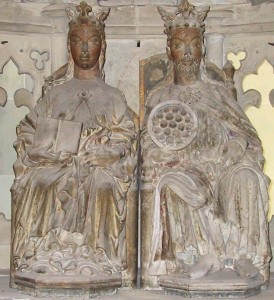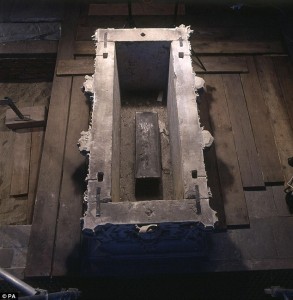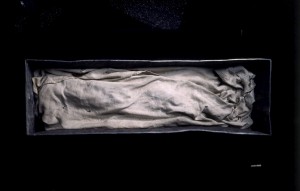 Queen Eadgyth (pronounced Edith) was the granddaughter of Alfred the Great. Her half-brother Athelstan unified disparate Saxon and Celtic kingdoms and is thus considered the first king of England.
Queen Eadgyth (pronounced Edith) was the granddaughter of Alfred the Great. Her half-brother Athelstan unified disparate Saxon and Celtic kingdoms and is thus considered the first king of England.
When Eadgyth was 19, Athelstan sent her and her half-sister Algiva or Adiva to Germany, telling the then Duke of Saxony to pick the one he liked best. Eadgyth was said to the prettiest and the Duke married her in 929 A.D.
That Duke later became Otto I, Holy Roman Emperor. Eadgyth bore him two children and died at the young age of 36 in 946 A.D. She was buried in the Cathedral of Magdeburg. Otto died 26 years later in 973 and although he had remarried after her death, he chose to be buried next to Eadgyth in Magdeburg.
Their remains didn’t stay put. Over the years they were moved several times, the last time in 1510 when the fancy cenotaph was erected in the Cathedral. People thought that it was just a marker, not the actual location of her bones, so when archaeologists researching the cathedral opened the vault they were shocked to find a lead coffin marked with Queen Eadgyth’s name and the 1510 date.
Inside they found a skeleton wrapped in silk. The bones belong to a woman between the ages of 30 and 40. That’s not final confirmation that the bones belong to Queen Eadgyth, of course. We’ll have to wait for the results of chemical analysis to know for sure.
In particular they will try to match radioactive isotopes embedded in the bones to those found in her birthplace in England.
Professor Mark Horton, of the Department of Archaeology and Anthropology, who is co-ordinating the research, said: “We know that Saxon royalty moved around quite a lot, and we hope to match the isotope results with known locations around Wessex and Mercia, where she could have spent her childhood.
“If we can prove this truly is Eadgyth, this will be one of the most exciting historical discoveries in recent years. It is quite a surprise to find them so much in tact. It really is an important discovery.”
No earlier remains of an English royal are extant. Her brother Athelstan’s tomb is still extant in Malmesbury Abbey, Wiltshire, but archaeologists think it’s empty.

